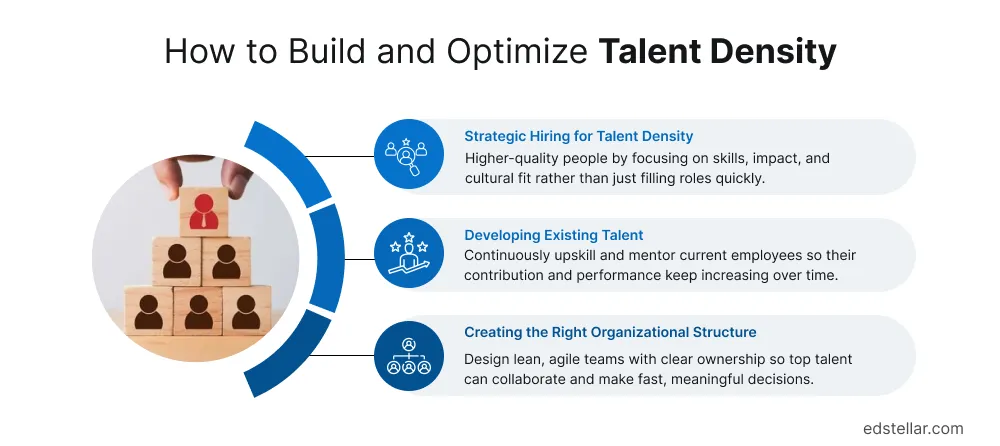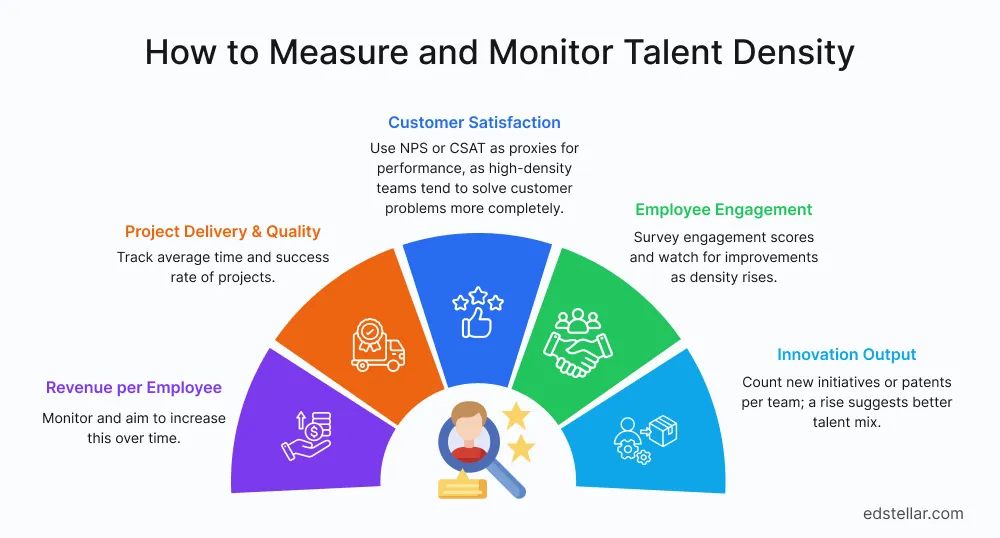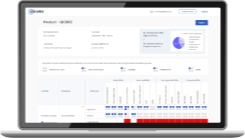
Every organization tracks headcount. But far fewer track something far more telling: how much of that headcount is truly high-performing.
Talent density, the proportion of top performers within your workforce, is emerging as one of the most decisive indicators of organizational health and capability. It’s not about having more people; it’s about having more of the right people in the right roles, working in ways that elevate one another.
And HR leaders are in a unique position to surface this number, monitor it like a vital sign, and design strategies that improve it over time.
Netflix is perhaps the most famous example of this mindset. Its co-founder Reed Hastings once said, “In all creative roles, the best is easily ten times better than average.” The company doesn’t aim for balanced teams, it aims for high-density ones. And the results are visible: with fewer than 20,000 employees, Netflix generates roughly $3 million in revenue per employee, double Google’s figure and nearly ten times that of Disney.
“Talent Density is the quality and density of skills, capabilities, and performance you have in your company.” — Josh Bersin.
This guide examines talent density in depth: defining what it means, why it matters more than headcount, and how to measure, build, and sustain it. Along the way, we’ll show how concentrating talent multiplies output, innovation, and agility.
You’ll learn practical assessment tools (like skills inventories and performance matrices) and strategies (from strategic hiring to continuous development) to raise your organization’s talent density. You will also be exposed to pitfalls to avoid when trying to improve talent density.
What Is Talent Density?
Talent density measures the concentration of top performers in an organization. At its core, it reflects the depth and distribution of high-value talent, not just how many people you employ, but how many of them are truly excelling in roles that matter.
In practical terms, it is often calculated as the ratio of high-performing employees to total headcount. For clarity, consider this formula:
In other words, if 30 out of 100 employees are high-impact contributors, your talent density is 30%. A higher ratio means the overall workforce is stronger. As one corporate guide notes, talent density is “the concentration of highly skilled and high-performing employees within an organization or team.”
This differs from headcount, which is just the total number of people. A small team with a high proportion of top talent can vastly outperform a larger team of average performers. In Netflix’s words, “We aim only to have high performers…people who are great at what they do, and even better at working together.”
Traditional hiring focuses on filling seats quickly, but a talent-density mindset asks: How do we fill seats with the right people? This means carefully defining high-impact roles, recruiting for skills and potential (not just credentials), and weighing each hire’s likely contribution.
It also calls for a more deliberate approach to how teams are built, managed, and developed. High talent density isn't a one-time hiring outcome it's a continuous process of raising the bar across hiring, development, and culture.
Once this mindset takes hold, organizations begin to look deeper:
- Which roles truly demand top-tier talent?
- Where do performance bottlenecks exist today?
- Who’s elevating team results, and who’s holding them back?
These are the questions that pave the way for a skills-intelligent, performance-aware organization, where tools and data systems can amplify what HR already observes.
Why Talent Density Matters More Than Headcount
When performance stalls, adding more people isn’t the answer adding the right people is. That’s the shift talent density brings into focus.
It’s not a feel-good HR concept. It’s a way of thinking that connects individual capability with organizational outcomes. Whether you're scaling fast or tightening budgets, the mix of talent on your team has a direct impact on how well, and how fast, your organization performs.
Even modest increases in the proportion of high-impact talent can change the equation. Teams with stronger average capability move faster, solve problems better, and require less oversight. The result? Higher output, greater agility, and better decisions, without inflating team size or cost.
A s Josh Bersin observes, relying on outdated bell-curve appraisal systems leaves “the bulk of the company…rated 2 or 3…destined to be medium in performance.”
In contrast, a talent-density mindset treats each hire as a “force multiplier” for the team. A single strong leader or engineer can lift the productivity of everyone around them. Reed Hastings put it bluntly: “Talented people make one another more effective,” meaning one top performer can elevate the work of their peers. This focus shifts the hiring philosophy from quantity to quality, going after “the best” rather than just filling positions.
High talent density pays off in every way:
- Productivity & Performance: Teams with more high performers require less supervision and simply “produce better results.” They also tend to work faster and smarter. By sharing expertise and tackling complex problems together, a dense team can innovate more rapidly.
- Culture & Morale: A competitive, excellence-oriented culture takes hold. High performers “inspire each other” and create a virtuous cycle: top talent attracts top talent. Ordinary employees rise to the challenge when surrounded by stars.
- Engagement & Retention: Talented people prefer to work with other talented people. Research finds that employees in high-density teams stay longer, reducing turnover. (Replacing workers is costly; on average, 40% of salary, so keeping top performers is a big win.)
- Agility & Decision Speed: Dense teams can pivot quickly. With less hand-holding required, they can make data-driven decisions faster and respond rapidly to market changes. In short, they act like a nimble “anti-fragile” organization that thrives under pressure.
- Innovation & Market Advantage: High-density teams generate 2–3× more new ideas and launch products faster (thanks to tighter collaboration and problem-solving). They also tend to win higher customer satisfaction, as the quality of work improves (satisfied clients reinforce brand reputation).
Putting talent density first even delivers cost efficiency.
Consider two cases: a large team of 100 managed conventionally vs. a lean team of 50, all high performers. The smaller, skilled team can achieve more with fewer managers and overhead, lowering salary/benefits costs. As one expert notes, a high-density team may have “fewer but more innovative and effective employees” than a bloated staff.
Moreover, turnover and training expenses plummet: replacing an average employee can cost more, but a dense team that retains talent avoids those recurring costs. In practice, Deloitte research shows companies using skills-first talent models are 98% more likely to retain high performers, directly boosting ROI on hiring and training investments.
The Business Case for High-Performing Teams
Organizational metrics consistently reflect the payoff of talent density. One way to see it is revenue-per-employee. For example, McKinsey reports that agile organizations with empowered teams (a proxy for high talent density) are far more likely to be in the top quartile of company performance.
Another industry case: Schneider Electric built an internal talent marketplace to surface in-house experts. In just 2 months, 60% of employees signed up for new roles, and Schneider unlocked 127,000 hours of “hidden” expertise, directly fueling productivity.
High density also sharpens competitive advantages:
- Market Agility: Dense teams respond to trends ~3× faster. With streamlined decision chains and broad skills overlap, they reconfigure strategies rapidly.
- Innovation: By sharing diverse perspectives, high-density teams generate roughly twice as many novel ideas as siloed groups. Indeed, Google’s famous “20% time” innovation model partly assumes a baseline of top talent to launch side projects effectively.
“We encourage our employees, in addition to their regular projects, to spend 20% of their time working on what they think will most benefit Google,” founders Sergey Brin and Larry Page wrote in their IPO letter. “This empowers them to be more creative and innovative. Many of our significant advances [like AdSense and Google News] have happened in this manner.”
- Customer Satisfaction: Clients notice quality and consistency. Although hard figures vary, companies with high retention and engagement have higher Net Promoter Scores (an index that measures a customer's willingness to recommend a company's products or services to a friend or colleague) due to better service and products.
- Brand Reputation: Firms known for top talent attract premium recognition. Clients and recruits alike associate a dense workforce with reliability and cutting-edge expertise.
In short, talent density compounds positive outcomes across productivity, growth, and efficiency. The key is turning these concepts into measurable goals and processes, which we address next.
How to Assess Your Current Talent Density
Before you build density, you must measure it. Assessing talent density involves identifying top performers and mapping skills across teams. Here are practical tools:
- High-Impact Contributors Matrix: Compile recent performance scores, peer reviews, and business impact. A simple table helps spot stars:
Use existing review data and 360° feedback (a process where individuals receive performance feedback from multiple sources, including their manager, peers, direct reports, and even themselves) to rank contributions. It’s combining “performance evaluations and productivity benchmarks,” including revenue-per-employee metrics, to gauge quality. You can also track high-performer ratios: what percentage of team members meet a ‘top performer’ threshold?
- Skills Distribution Heatmap: Create a skills matrix to visualize how expertise is spread. For each key skill, rate levels (e.g., Advanced/Intermediate/Basic) across employees or roles:
This “heatmap” approach quickly shows skill gaps and clusters. According to talent research, mapping competencies with tools like skills assessments or framework software is essential to “identify skill gaps” and target development. It also helps you see if multiple employees share the same strengths (duplication) or if some critical skills exist only in one person (risk).
- Performance-to-Headcount Ratios: Analyze metrics that link team size to output. Key ratios include revenue per employee, profit per employee, and project delivery speed. Other KPIs: average time to complete projects, customer satisfaction, or defect rates. VelocityGlobal’s advice is to monitor “productivity benchmarks” and “employee output against standards.”
In summary, use both qualitative (reviews, peer ratings, interviews) and quantitative metrics (revenue/employee, retention, engagement) to assess talent density. Compare departments to spot weak points. A small team with a poor score might signal a lot of average performers; a large team with high ratios indicates healthy density. Armed with these insights, you can target initiatives effectively.
How to Build and Optimize Talent Density
Raising talent density is a multi-pronged effort involving hiring, development, and culture:

Strategic Hiring for Talent Density
Recruitment sets the foundation. Adopt skills-based, competency-focused hiring as your default. This means writing job descriptions that emphasize impact (“What critical problems will this role solve?”), designing interview questions that assess core competencies, and using work simulations or assessments instead of just résumés.
Prioritize quality over quantity; thoroughly screen each candidate’s fit and potential rather than rushing to fill seats.
- Impact-Focused Job Descriptions: Define roles by desired outcomes and skills, not just titles. Mention projects or KPIs (e.g., “increase user engagement by X%”).
- Performance-Based Interviews: Structure interviews to test critical abilities (e.g., coding tests, case studies, or portfolios). Include technical or situational exercises that mimic actual job tasks.
- Cultural Fit Assessments: Use behavioral questions and peer interviews to ensure candidates align with your high-expectation culture. (A cohesive culture keeps top performers engaged.)
- Rigorous Onboarding: Once hired, onboard new employees with clear expectations and early wins. Immersive training and quick integration into high-impact projects help them contribute right away.
As one talent expert puts it, each new hire should “bring new ideas, skills, and perspectives beyond the job as defined.”
In practice, this approach mirrors how tech giants operate: Google, for instance, has a multi-stage hiring process including work-style assessments and structured interviews to maintain its talent density.
Developing Existing Talent
Talent density isn’t static; you can grow the performance of your current people. Implement career pathways and development programs so employees can level up. For example:
VelocityGlobal recommends making training a strategic priority: providing “continuous learning opportunities and upskilling programs” (workshops, mentorship, eLearning) boosts each person’s value and thus overall density.
Similarly, establish performance improvement plans for those just below the top-performer level. With coaching and stretch assignments, many can rise. Only after giving underperformers clear improvement paths should tough decisions (reassignment or termination) be made. Removing a low performer effectively raises your density by one high performer (even if the replacement takes time).
Creating the Right Organizational Structure
Your org design influences density. An overly hierarchical, siloed structure dilutes talent impact. Compare:
Research shows that flatter, cross-functional teams accelerate productivity and agility. High performers thrive when they can self-organize around solving problems, not under rigid command chains.
Encourage T-shaped teams (deep expertise plus broad collaboration skills) and give teams autonomy. Clear role definitions still matter: everyone should know their domain. But emphasize accountability for results rather than strict reporting lines.
In short, streamline the structure so that talented individuals can make decisions and move at top speed. This often means mini-teams or pod structures with each member pulling maximum weight.
How to Measure and Monitor Talent Density
Once initiatives are in place, keep tracking key metrics:

- Revenue per Employee: Monitor and aim to increase this over time. E.g., aim for a year-over-year lift; even a 10–15% bump is significant because it reflects how efficiently high-performing talent drives business value.
- Project Delivery & Quality: Track average time and success rate of projects. Faster completion and fewer defects indicate effective, dense teams.
- Customer Satisfaction: Use NPS or CSAT as proxies for performance, as high-density teams tend to solve customer problems more completely. And consistently high scores indicate that talent-dense teams are delivering meaningful, customer-centered outcomes.
- Employee Engagement: High performers in a strong culture drive engagement. Survey engagement scores and watch for improvements as density rises.
- Innovation Output: Count new initiatives or patents per team; a rise suggests better talent mix.
Also, establish a KPI dashboard for talent metrics. For example:
Link each metric to outcomes (e.g., customer satisfaction correlated with a product team’s talent mix). As capacity grows, such data provides continuous feedback on your talent-density strategy.
Using Skills Intelligence to Track Progress
A key accelerator is a Skills Intelligence Platform. In practice, modern HR tech can continuously map skills across the company and tie them to business results. Indeed, Parita defines skills intelligence as “the application of analytics, machine learning, and NLP to transform raw skills data into real-time insights.” In other words, it turns a fragmented HR database into an always-updated skills map.
Core features include a dynamic skills inventory that gives managers a constantly updated view of team capabilities, and gap analysis tools that highlight areas where critical skills are missing. This helps organizations target training, development, or recruitment efforts precisely where they’re needed. For example, identifying a shortage of cloud expertise on a specific team allows for quicker intervention.
Beyond gap detection, these platforms enable performance correlation, showing which skills contribute most to business results, such as revenue growth or successful project delivery. They also offer predictive analytics, allowing HR to forecast how changes in the workforce, like staff turnover or new hires, could affect future performance.
By providing deep visibility into workforce strengths and weaknesses, skills intelligence supports faster, more informed decisions, helping leaders identify adaptable employees and design high-impact training strategies.
Continuous Improvement and Monitoring
Building talent density is an ongoing cycle, not a one-time fix. Embrace a continuous improvement loop:
- Assess: Regularly audit talent metrics (as above), review skills dashboards, and gather team feedback.
- Act: Implement targeted actions (e.g., hire for skill X, launch a leadership course, reassign a low-impact employee).
- Analyze: Measure the impact of those actions on your KPIs over weeks or months.
- Adjust: Refine your approach. Maybe try a different assessment method or refine a competency model.
Embed this cycle in quarterly or annual planning. For instance, set a goal (“increase high-performer% by 10pp”) and use data to track progress weekly. Encourage leaders to review talent density in every planning meeting. Over time, this loop becomes part of your culture: leaders adjust team composition or training investment based on solid data, not gut feel.
Implementing Talent Density: Getting Started
- Baseline Assessment: Use the tools above to establish current talent density. Identify which departments or roles are weakest. Survey managers on skill gaps and performance bottlenecks.
- Goals & Alignment: Meet with executive leadership to set clear targets (e.g., % of roles to be top-performer grade, revenue/employee goals, or training coverage). Ensure all business units buy in, as success requires a unified vision that “each hire should multiply capability,” not just check a headcount box.
- Pilot Program: Try tactics in a smaller context. For example, launch skills-based hiring in one department and measure candidate quality, or use mentors in one team and track performance gains. Pilots let you fine-tune methods before scaling.
- Gradual Rollout: Roll out successful strategies company-wide. Introduce the Skills Intelligence Platform slowly; perhaps start with a key division to collect skills inventory data and iterate. Meanwhile, integrate talent density concepts into HR processes (performance reviews, hiring panels, etc.).
- Review & Iterate: After each quarter or project cycle, review outcomes vs. your targets. Celebrate wins (e.g, revenue growth or reduced turnover in high-density teams) to maintain momentum. Keep refining KPIs and tools.
Common Pitfalls to Avoid when Building Talent Density
- Over-Focus on Credentials: Avoid filling roles based on degrees or titles alone. Real performance comes from actual skills and results.
- Ignoring Culture Fit: A room full of high performers still needs cohesion. Don’t push star employees into teams where they clash with core values.
- Rushing Change: Drastic re-orgs without change management can backfire. Communicate why talent density matters and involve managers early.
- Metric Misalignment: Don’t just count activities (e.g., resumes reviewed); track impact (quality of hire, productivity).
- Neglecting Stakeholders: Involve team leads and HR in the planning process. They must own the change, not have it imposed.
By watching for these warning signs and proactively managing them, you keep the focus on real performance improvement, not just process.
Building Leadership Buy-In
To secure lasting support, tie talent density to hard business outcomes. Calculate the ROI: for example, show how reducing turnover (each quit costs ~40% of that salary) and improving revenue per employee can pay back the investment in new hiring processes or training.
Use case studies: cite success stories like Schneider Electric’s talent marketplace or Google’s rigorous hiring, or internal wins from your pilot tests. Prepare a clear cost-benefit analysis (e.g., “each star performer hired is estimated to add X% productivity”).
Also address risks: plan phased changes, so you can adapt if something isn’t working. Emphasize that this is an evolution of the current HR strategy, not a wholesale revolution overnight.
Finally, keep communicating results to the executive team. Quarterly reports showing improved performance KPIs, higher engagement scores, and positive survey feedback will help “get everyone rowing in the same direction” on talent density.
Ready to Transform Your Organization?
Building talent density is about prioritizing quality over quantity in every aspect of your workforce, from recruitment to daily collaboration. The result? A more productive, innovative, and resilient organization poised for long-term success. With Edstellar, the ultimate corporate training provider, you can unlock this potential through a powerful combination of data-driven skills intelligence, and strategic workforce planning.
Edstellar stands out as a one-stop instructor-led corporate training and coaching solution, addressing global organizational upskilling and talent transformation needs. Offering over 2,000 tailored programs across diverse disciplines, including Technical, Behavioral, Management, Compliance, Leadership, and Social Impact, to ensure your workforce is equipped with the skills needed to thrive in the business landscape.
At the heart of Edstellar’s transformative approach is its cutting-edge Skills Intelligence Platform, featuring advanced tools like the Skill Matrix. These solutions empower organizations with precise skills mapping, competency management, and performance analytics, enabling you to identify skill gaps, tailor training programs, and track progress with unparalleled accuracy. Whether delivered onsite or virtually, our flexible, expert-led training ensures seamless integration into your team’s schedules, driving measurable outcomes and fostering a culture of continuous learning.
Start your talent density journey today with Edstellar. Schedule a demo to explore how our comprehensive training solutions and innovative skill management software can elevate your workforce and position your organization for success in an ever-evolving market.
Explore High-impact instructor-led training for your teams.
#On-site #Virtual #GroupTraining #Customized

Bridge the Gap Between Learning & Performance
Turn Your Training Programs Into Revenue Drivers.
Schedule a ConsultationEdstellar Training Catalog
Explore 2000+ industry ready instructor-led training programs.

Coaching that Unlocks Potential
Create dynamic leaders and cohesive teams. Learn more now!


Want to evaluate your team’s skill gaps?
Do a quick Skill gap analysis with Edstellar’s Free Skill Matrix tool

Transform Your L&D Strategy Today
Unlock premium resources, tools, and frameworks designed for HR and learning professionals. Our L&D Hub gives you everything needed to elevate your organization's training approach.
Access L&D Hub Resources.svg)
.svg)



.svg)

.svg)
.svg)
.svg)
.svg)

